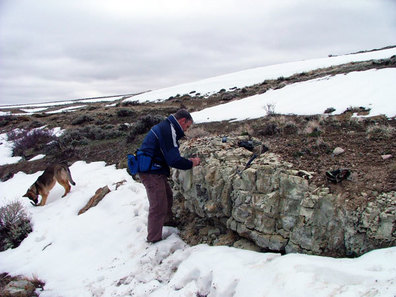| |
|
Follow Us:
|


|

WSGS geologist Robert Gregory examines an Eocene-aged rock outcrop for a potential zeolite deposit in Park County, Wyoming. Zeolite is a mineral widely used as a commercial absorbent for such such products as laundry detergent. It is also used by the agriculture and petroleum industries, as well as for water and air purification processes, as a concrete additive, and for pollution control and clean-up efforts. (Photo by David C. Micale)
 We are pleased to announce our new electronic newsletter,
which we named after our past popular journal series, "Wyoming Geo-Notes."
This quarterly news source is intended to keep you informed
of our services and current activities. We are pleased to report in this issue
the release of a major study on the Platte River Basin, conducted by our geologists
for the Wyoming Water Development Commission. We also highlight several map
projects that we have recently completed, as well as our new Geologic Hazards
website and interpretive signage project for Vedauwoo Recreation Area, to name
a few.
Our research and information is intended for a variety of audiences,
covering energy and mineral resources, water resources, and mapping and
hazards. We hope you find our e-newsletter "Wyoming Geo-Notes" interesting and informative, a new
service of the Wyoming State Geological Survey.
Tom Drean
|
Check out the WSGS website for all our reports, maps, and educational initiatives, at www.wsgs.uwyo.edu.
 Future groundwater development in the
Platte River Basin was evaluated as “fair to very good” in certain geologic
aquifers, but new projects will need to comply with current water decrees and
multi-state conservation plans.
The Wyoming State Geological Survey
(WSGS) has completed a major study on the groundwater resources of the Platte
River Basin, a project for the Wyoming Water Development Commission. Due to the
complex geology of the basin, geologists took an aquifer-by-aquifer approach
while assessing each geologic formation for its hydrological conditions.
Read more...
|
|
| WSGS Newsletter - Winter 2014
Wyoming Geo-Notes
|
|